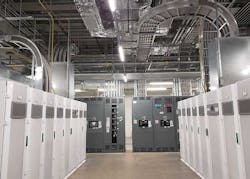Power Quality Monitoring & its Impact on Today’s Data Centers
This post continues a new special report series and highlights the ins and outs of power quality management (PQM) for today’s data centers and the influence of power quality on data performance and integrity.
Get the full report.
Older and smaller data centers usually lack basic power measurement or monitoring systems. In those cases, the only way they become aware of a potential power problem is when IT support personnel report the issue. In some cases, even when redundant A-B power paths exist, if one side of redundant circuits fail, IT administrators may not be aware of the exposure since the IT equipment that have dual power supplies will continue to operate. Even many newer, larger data centers which may have more comprehensive power measurement at the branch circuit level, do not have a complete picture of some of the issues of assessing power quality to IT equipment.
PQM is now More Affordable and Cost Effective
There is significant and increasing investment in redundant backup power systems to ensure availability. However, historically, the relatively high cost of purchasing and installing power quality monitoring with sufficient granularity and sensitivity to detect and identify power quality issues throughout the power chain has been an inhibitor in the data center industry. As a result, it was not typically specified unless there were obvious known or expected power problems. More recently, just as the cost of other digital devices have come down while becoming more powerful; PQM has also become more sophisticated and intelligent. The result, now PQM is far more cost effective and justifiable, even for smaller data centers.
If There is a UPS to Provide “Clean” Power Why Would we Need a PQ Monitor for the ITE?
The backbone of ensuring clean uninterrupted power to ITE, is the “double conversion” on-line UPS. While this type of UPS does isolate and mitigate most utility side power problems, it cannot protect ITE from power issues such as noise from harmonics which are generated downstream of the UPS output.
By their very nature ITE Power Supply Units (PSU) are nonlinear loads which can introduce harmonic distortion. In addition to the issues generated by the ITE PS themselves, other equipment such as some supplemental high density cooling systems (typically fan motors with variable frequency/speed controllers) that are also powered by the UPS.
IT Power Supplies
Computer and Business Equipment Manufacturers Association (CBEMA) was reorganized and was renamed the Information Technology Industry Council (ITI).
The CBEMA chart originated in the 1970s and was widely referenced in the IT industry for several decades. While it was updated and superseded in 2000, by Information Technology Industry Council ITIC curve (New CBEMA Curve), they are still not immune to surges, spikes and other disturbances, such as harmonic distortion and related noise.
Furthermore, the drive for energy efficiency has resulted in significant improvements in ITE PS electrical characteristics. Nonetheless, theses PSUs are based on switched-mode power conversion. They still have input power factors and harmonic distortion. While ITE power supplies have greatly improved in energy efficiency and power factor, they can still introduce harmonic into the power distribution system.
The US Energy Star program for data center equipment has detailed this in their specifi-cations. However, while these specifications apply to latest Energy Star PS requirements, many non-ES servers PS many have greater THD and lower PF. This is especially true for non-major server vendors and for older servers.
Note that the power factor decreases at lower loads. For those data centers that use dual corded redundant PS, the normal load on each PS is usually much less than 50%, which results in a lower power factor.
PQ Influence on Data Network Performance and Integrity
Moreover, it is the harmonics which can generate electromagnetic interference (EMI) which poses a separate potential threat to the IT network, either by being induced in the unshielded copper Ethernet distribution cable system and copper jumper cables which reside in close proximity to the power cables in each ITE cabinet. This is especially true as power demands and equipment density have increased substantially, resulting in greater EMI emission within the cabinet.
The power path can range from a very basic single path design or contain as many redundant components as required to deliver desired level of fault tolerance which is considered by many as the primary measure of evaluating electrical availability to the IT equipment and cooling systems, as well as other miscellaneous loads, such as lighting, and other security and support functions.
While fiber optics cables are essentially immune from electromagnetic interference, however network cabling systems built with un-shielded copper conductors are vulnerable to interference from several sources: stray magnetic fields, harmonics or noise induced from nearby power cables and ground currents. These sources are typically related to the power-distribution system and its associated cabling. This potential exposure can also increase when network cable trays are closely run in parallel with non-metallic power distribution cables to IT cabinets.
The susceptibility of unshielded cables to noise increased as Ethernet speeds grew from 100 megabits second to 1, 10, 40 gigabits second. In some cases, a small amount of noise may cause some data packet transmission errors, which modern network equipment can detect and can accommodate by resending the packet. However, this does reduce the throughput of the network.
Effect of Increased Power Density
Power density per rack has gone from 3-5 kW, and now ranges from 5-15 kW or even higher in some cases. While there are many challenges for cooling these racks, electrically delivering higher power is relatively straightforward. It became common to see multiple 20-30 amp single phase circuits and PDUs (which take up significant space, blocking airflow), in each rack in order to meet the rising power demands. As a result, many organizations have been moving toward 3-phase power distribution to the rack to reduce the number of PDUs.
The majority of ITE used in data centers use single phase power. In the U.S., single phase circuits to the rack are either 120 or 208 volts. This is derived from 3 phase 208V power panels on the wall or from PDUs on the floor. As noted previously, ITE use switched-mode power supplies, which, while power factor corrected, produce harmonic distortion, as well as varying the power factor and crest factor in relation to load conditions.
In the coming weeks, this special report series will further explore topics like the impact on power distribution, PDU transformers, grounding issues, data center infrastructure monitoring and more. Catch up the first entry, as well.
Download the full report, “Understanding the Importance of Power Quality in the Data Center,” to explore the importance of power quality in the data center.

